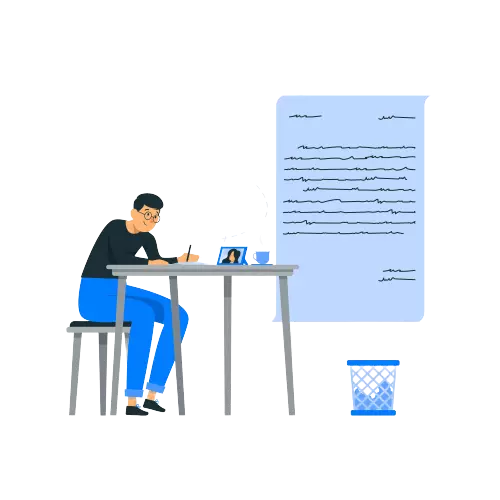What are Credible Sources – Tips to Identify Them With Examples
Published by at October 12th, 2023 , Revised On January 15, 2025
In today’s information age, distinguishing between credible and unreliable sources is paramount. Whether you’re a student working on a research paper, a journalist crafting a news article, or simply a curious individual seeking reliable information, identifying credible sources is a critical skill.
In this comprehensive guide, we will explore what credible sources are? What makes a source credible, the types of credible sources available, where to find them, and how to evaluate web sources? Additionally, we will discuss concepts such as peer review, academic dishonesty, and differentiating between primary and secondary sources.
What is a Credible Source?
A credible source can be trusted to provide accurate, reliable, and unbiased information. Credible sources are essential for various purposes, including academic research, journalism, decision-making, and gaining knowledge on various topics. Credibility hinges on factors such as the source’s reputation, expertise, transparency, and the rigour of its research methods.
What Makes a Source Credible?
To determine the credibility of a source, consider the following criteria:
-
Author’s Qualifications
Check the author’s credentials and expertise in the field. Are they qualified to speak on the subject?
-
Publication Source
Examine where the information is published. Reputable sources include peer-reviewed journals, established news outlets, government websites, and academic institutions.
-
Citations and References
A credible source will provide citations and references to support its claims, allowing you to verify the information independently.
-
Objectivity and Bias
Evaluate whether the source exhibits bias or maintains objectivity. Credible sources strive to present balanced viewpoints.
-
Accuracy and Timeliness
Ensure that the information is up-to-date and accurate. Outdated or inaccurate information can lead to misinformed decisions.
Now that we understand the characteristics of credible sources let’s explore the different types of sources that meet these criteria.
Types of Credible Sources
Credible sources come in various forms, each serving a unique research and information-gathering purpose. Here are some common types:
-
Academic Journals
These are scholarly publications that undergo rigorous peer review. They are excellent sources for academic research.
-
Books
Authored books, especially those published by reputable publishers, provide in-depth knowledge on specific subjects.
-
Government Publications
Government websites and reports offer official information and statistics, often highly reliable.
-
News Outlets
Established and respected news organisations are valuable current events and general knowledge sources.
-
Educational Institutions
Websites of universities and educational institutions often host credible research papers, articles, and resources.
-
Experts and Interviews
Interviews with subject experts or specialists can be credible sources if the interviewee has expertise in the field.
Now that we know where to find credible sources let’s explore strategies for locating them effectively.
Where to Find Credible Sources
Finding credible sources can be daunting, especially with the vast amount of online information. Here are some strategies to help you locate them:
-
Library Databases
University and public libraries provide access to a wealth of academic databases and journals.
-
Online Libraries
Websites like Google Scholar, JSTOR, and Project MUSE index a vast array of scholarly articles.
-
Government Websites
Government agencies often publish reports, statistics, and official information online.
-
Educational Institutions
Explore the websites of universities and colleges for academic resources and research papers.
-
Reputable News Outlets
Trustworthy news sources like BBC, The New York Times, and Reuters offer reliable information on current events.
-
Reference Books
Encyclopedias and reference books provide foundational knowledge on various topics.
With these strategies in mind, you can navigate the information landscape more effectively. However, evaluating their credibility is crucial even when you find potential sources.
Evaluating Web Sources
The internet is a treasure trove of information but is also rife with misinformation and unreliable sources. When evaluating web sources, consider the following tips:
-
Check the Domain
Examine the website’s domain. Government, educational, and non-profit organisations typically have more reliable information.
-
Authorship
Look for information about the author or organisation responsible for the content. Lack of authorship or transparency is a red flag.
-
Publication Date
Ensure that the information is current. Some topics require the latest data and research.
-
Cross-Check Information
Verify facts and claims by comparing information from multiple credible sources.
-
Bias and Objectivity
Assess whether the source displays bias or maintains objectivity. Be cautious of sensationalism and extreme viewpoints.
-
Citations
Determine if the source provides citations and references to support its claims.
-
Site Design
While not foolproof, professional and well-maintained websites often indicate credibility.
Applying these principles allows you to sift through web sources more effectively and identify the reliable ones.
The research done by our experts have:
- Precision and Clarity
- Zero Plagiarism
- Authentic Sources

Examples of Credible Vs. Non-Credible Sources
Let’s put the knowledge gained into practice by examining examples of credible and non-credible sources on a specific topic:
Topic: Climate Change
Credible Source
- An article on climate change was published in the peer-reviewed journal “Environmental Science & Technology.”
- The Intergovernmental Panel on Climate Change (IPCC) report is available on its official website.
- A book on climate science authored by a climatologist and published by a reputable academic press.
Non-Credible Source
- A blog post on a personal website claiming that climate change is a hoax.
- A social media post with no sources or citations that argues against the consensus on climate change.
- An article on a news aggregation website with no byline or references to credible scientific studies.
Ensuring Credibility and Integrity in Academia: Peer Review and Academic Honesty
The Importance of Peer Review
Definition of Peer Review
Peer review is a crucial process in academic publishing. It involves experts in a particular field critically evaluating research articles before they are published in academic journals.
Here’s how peer review works:
-
Submission
An author submits their research article to a peer-reviewed journal.
-
Expert Evaluation
The journal’s editor sends the article to experts (peers) in the same field for review.
-
Feedback and Revision
Peers assess the article’s quality, methodology, and validity. They may suggest revisions or reject the article if it doesn’t meet scholarly standards.
-
Publication
If accepted, the article is published, indicating that it has passed the scrutiny of experts in the field.
Peer review ensures that published research is of high quality and credibility. When conducting academic research, prioritise peer-reviewed sources to bolster the reliability of your work.
Academic Dishonesty: What You Should Know
Academic dishonesty refers to unethical behaviour in academia, which includes plagiarism, cheating, and the fabrication of data. It undermines the credibility of the individuals involved and the institutions they represent. To maintain your credibility and uphold academic integrity, familiarise yourself with your institution’s academic honesty policies and always attribute sources properly in your work.
Differentiating Primary and Secondary Sources
In research, it’s essential to differentiate between primary and secondary sources:
-
Primary Sources
These are original, first-hand documents or materials created during the event or research. Examples include diaries, letters, photographs, and scientific studies.
-
Secondary Sources
Secondary sources provide analysis, interpretation, or commentary on primary sources. Examples include books, reviews, and articles that discuss or summarise research.
Understanding the distinction between primary and secondary sources helps you assess the depth and perspective of the information you encounter during your research.
Conclusion
Subsequently, in today’s information-driven society, finding reputable sources is a vital aptitude. You may confidently navigate the information sea by understanding what makes a source reputable, knowing where to find it, and refining your evaluation abilities.
Recognising the value of peer review, avoiding academic dishonesty, and distinguishing between primary and secondary sources all help you get accurate information and contribute to the body of knowledge. So, use the above tips and approaches to become a more discerning consumer and provider of credible data.
Frequently Asked Questions
Table of Contents
Credible sources are trustworthy and reliable providers of information. They are important because they ensure the accuracy of your research and help you make informed decisions.
You can assess source credibility by checking the author’s qualifications, the publication outlet, citations and references, objectivity, accuracy, and publication date.
Reliable academic sources are often found in academic journals, books, government publications, university websites, and libraries.
Peer review is a process where experts evaluate research before publication. It’s critical because it ensures high-quality and verified information.
Avoid academic dishonesty by properly citing sources using citation styles like APA, MLA, or Chicago, and always giving credit to the original authors to maintain integrity in your work.






